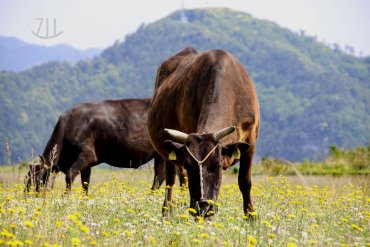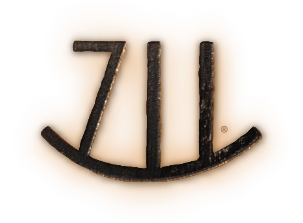 The term “WAGYU”—properly pronounced “waa-gyew”—literally means “Japanese cow” in Japanese. “Wa” means Japanese and “gyu” means cow.
The term “WAGYU”—properly pronounced “waa-gyew”—literally means “Japanese cow” in Japanese. “Wa” means Japanese and “gyu” means cow.
In Japan the term Wagyu refers to one of four major “strains” of beef cattle that were “improved by crossbreeding with non-Japanese cattle during a short period between approximately 1867 and 1910. In Japan these four major strains of Wagyu include Japanese Black, Japanese Brown, Japanese Polled and Japanese Shorthorn.
In Japan these four major strains of Wagyu include Japanese Black, Japanese Brown, Japanese Polled and Japanese Shorthorn. The Japanese Brown are typically referred to outside of Japan as “Red Wagyu”, and also referred to by some as “Akaushi”, which means “red cow” in Japanese.
Only Japanese Black and Red Wagyu have been exported from Japan. There are a number of different major bloodlines within each of the four major strains of Wagyu.
The genetics of only 221 Wagyu animals are known to have been exported from Japan, all of which were exported between 1976 and 1997. This includes 167 Black Wagyu live animals exported from Japan to the U.S along with 21 calves sired by Japanese bulls born after the arrival of the females, and 16 Red Wagyu live animals exported from Japan to the U.S. along with 6 calves sired by Japanese bulls.
Realizing the substantial value of their unique beef cattle after this small number of Wagyu were exported, the Japanese government officially declared their Wagyu a national treasure and banned all further export of Wagyu cattle and genetics.
After the initial exportation of the original 183 live animals from Japan to the U.S., Wagyu genetics were exported from the U.S. to Australia, Canada and subsequently the Wagyu breed has spread across the globe, with all registered Wagyu animals outside of Japan originating from the genetics of the 221 original animals exported to the U.S.
Wagyu were originally draft animals used in agriculture in Japan, and were selected over a long period of time for their physical endurance. This selective breeding process with a goal of producing good draft animals, over many generations, favored the breeding of animals with more intra-muscular fat cells.
This intra-muscular fat, which the beef industry refers to as “marbling”, provided a readily available energy source, which allowed these animals to release large amounts of energy in a burst of work as draft animals.
The evolution of Wagyu separate and apart from other major lines of Bos taurus cattle and this selective breeding for work purposes over many years, complemented by an aggressive Japanese government-led breeding management program in the 20th century, resulted in breed now known around the world for the ultimate beef culinary experience.
Wagyu cattle arguably produce the best quality beef in the world, a beef product that is tender and highly marbled, with a low melting point fat that “melts in your mouth”. Wagyu beef is also more healthful than beef from other breeds of cattle due to a higher ratio of monounsaturated fatty acid as compared to saturated fatty acid.
Wagyu cattle produce very low birth weight calves, grow and mature slower and as adults are somewhat smaller than most European breeds. Wagyu have wonderful dispositions, breed earlier and live longer than European breeds, and are highly adaptable to a wide range of climates and terrains.
Wagyu bulls are known to be exceptionally fertile and have strong libido, enabling Wagyu bulls to breed a larger number of cows per bull compared to other breeds. It is not unusual for a single mature Wagyu bull to breed a herd of up to 50 cows.
Wagyu is a horned breed and the cattle are either black or red in color. Outside of Japan, there are four major strains, three black and one red. Because of the relative isolation of one Japanese prefecture to another and the selective breeding that took place in each area, different characteristics emerged from the various strains. However, having evolved from the native Asian cattle, the Wagyu bloodlines are somewhat related.
Tajima originated in the Hyogo prefecture, of which the city of Kobe is the capital. This bloodline descended from the sire Tajiri, a sire born in 1939 in the Mikata District of the Hyogo Prefecture. Animals from this bloodline are sometimes referred to as Tajiri. This is a large, influential sire-line to which almost all bloodlines within the Hyogo prefecture are related.

Tajima were originally used to pull carts and plows so over time they developed larger forequarters and lighter hindquarters. In Japan, this strain is generally regarded as producing the best quality meat as compared to the other strains. The Tajima strain is typically smaller framed, have slower growth rates and are frailer as compared to the other strains of Black Wagyu.
While all of the “Japanese Black” have been crossbred with non-Japanese cattle to some degree during the Japanese government-led improvement program that was in place between approximately 1867 and 1910, generally speaking, the Tajima line was less influenced by crossbreeding as compared to the other three lines of Wagyu. This strain produces excellent meat quality with a large eye muscle and superior marbling. They are also known for having an excellent temperament. This is the strain of Wagyu that made “Kobe Beef” famous outside of Japan.
Fujiyoshi originated with the sire Dai 13 Hanayoma in the Okayama prefecture of Japan. Over time the Fujiyoshi strain was introduced to other prefectures. Dai 7 Itozakura is probably the most famous of the Fujioshi strain, and was born in the Shimane prefecture.
A large portion of the Fujiyoshi strain Wagyu outside of Japan descended from Dai 7 Itozakura. For this reason, the Fujiyoshi strain is often referred to as Shimane. These animals are medium framed, have average growth rates as compared to the other 2 strains of Black Wagyu, have good maternal qualities, good fertility and produce good meat quality.
Kedaka originated in the Tottori prefecture, and this bloodline is also sometimes referred to as Tottori. This strain of Black Wagyu was originally bred to be used as pack animals in Japan. This selective breeding is believed to have resulted in the larger frame size, the straight, strong back lines and generally good growth rates of this strain of Black Wagyu.
The meat quality of this strain is somewhat more variable as compared to the Tajima line, but the milking ability is better as compared to the other 2 strains of Black Wagyu.
Red Wagyu are substantially different animals than the three strains of Black Wagyu. These animals are referred to within Japan as “Japanese Brown”, and outside of Japan are also sometimes referred to as “Akaushi” as well as “Kumamoto Red”.
Red Wagyu are a red hided animal that originated in the southern part of Japan, primarily in the Kumamoto prefecture, which is located on the island of Kyushu in southwestern Japan, where range grazing is more popular than the confinement operations typical in other parts of Japan.
The Red Wagyu bloodline is believed to have evolved from ancient Asian breeds that on the Southeast Asian mainland evolved into the red Korean breeds such as the modern Korean Hanwoo. This bloodline was then influenced during the Japanese government led improvement program by crossbreeding with certain European breeds, including primarily the Simmental and Devon breeds. Some reports indicate that Korean Hanwoo was also utilized in the crossbreeding program.
Red Wagyu are larger on average than the 3 main strains of Black Wagyu, grow faster and are thicker, heavier animals. There are many examples of excellent meat quality from Red Wagyu.
In Japan there are two other minor strains of Wagyu that have not been exported, the “Japanese Polled” and “Japanese Shorthorn”. These two strains of Wagyu were heavily influenced by crossing of European breeds with native Japanese cattle between 1868 and 1910, and make up a very small percentage of the total Wagyu herd in Japan.
Wagyu are genetically predisposed to produce excellent quality beef. Wagyu cattle arguably produce the best quality beef in the world, a beef product that is tender and highly marbled. Wagyu beef is also more healthful than beef from other breeds of cattle due to a higher ratio of monounsaturated fatty acid as compared to saturated fatty acid.
